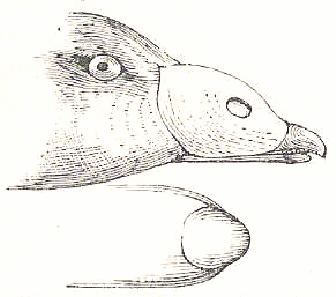|
|
|
Cereopis is a genus founded by Latham in 1801 (Suppl. Ind. Orn. p.
lxvii.) on a single specimen of a bird received from Australia apparently
in poor condition, and placed by him in the Order GRALLAE. A truer
view of its position was, however, taken by those who had observed it in
its own country, where it became known as the Cape-Barren Goose,
from its occurring at that spot
According to Sonnini, who called it "Le Cygne cendre"
(N. Dict. d'hist. nat. vii. p. 68), it was first-noticed by Labillardiere
in Esperance Bay on the south coast of New Holland, during the search by
D'Entrecasteaux for La Perouse in 1792. Collins in 1802 (New South
Wales, ii. p. 94) ascribes its discovery by the English settlers to
one of the company of the 'Sydney Cove,' who took it for a Swan; and Flinders,
who was there in February 1798, accordingly named from it two islands on
the north coast of Van Dieman's Land. Bass gave the first clear description,
stating that it "was either a Brent or a Barnacle Goose or between the
two".
|

Picture of beak and head of Cereopsis or the Cape Barren Goose
|
Appearance and Habits of the
Cape Barren Goose
Measuring between 75 and 100 cm, it is a large squat
goose with a remarkable appearance. Its gray-white plumage is spotted
with black on the wing-coverts and scapulars. The wingtips are black,
and it has black semipalmated feet and a short black bill with remarkable
thick yellowy green wax skin around the cere.
They live exclusively in Australia and on some
of the Tasmanian islands. Its preferred habitat is coastal plains
and fresh or brackish water lakes. They primarily feed on grasses
and small seeds and only rarely swim in the water.
It is a sociable species although the adults vigorously
and loudly defend their nests against the other individuals of the species.
The females call out rather serious sounding porcine growls, resulting
in the bird being sometimes called the Pig-goose. Males and females
are very similar in appearance.
A pair of Cape Barren Geese are faithful for life,
reproduction taking place between April and October. The nest is
built on the ground and made from dry grass, lined with down feathers.
Unlike other geese, the male helps with the building of the nest.
The female lays about four to seven cream colored eggs. After about one
month the chicks hatch, and are usually able to fly at the beginning of
spring.
|
|
However abnormal in appearance this bird may be,
in its internal structure it does not differ in the least important character
from other Geese. In its habits, whether at large or in confinement,
it is thoroughly a true GOOSE.
The Cape Barren goose was introduced to the UK
in the first half of the 19th century. Examples were transferred
from Windsor, where it had bred freely in the menagerie of King George
IV, to the Gardens of the Zoological Society at its foundation. Indeed,
it is not at all improbable that there were more living examples at that
time in Europe than in Australia, where, even when Gould was in that country
he found the Cape-Barren Goose to have been extirpated in places where
a few years before it had been abundant.
The Extinct South Island Goose
Additional interest was imparted to the exterpation
of the Cape-Barren Goose in many parts of Australia by the discovery in
New Zealand of remains originally attributed by Sir R.Owen (Proc. Zool.
Soc. 1865, p. 438) to the Dinornithidae family (MOA) under the name
of Cnemiornis calcitrans, and subsequently fully described by him
(Trans. Zool. Soc. v. pp. 395-404, pls. lxiii.-Ixvii.). The acquisition
in 1872 of a further collection of bones of this extinct bird enabled Sir
James Hector to recognize in it a large Goose, probably allied to Cereopsis
and of similar habits, but in which the power of flight had become
obsolete, and as such he described it before the Wellington Philosophical
Society, 18th August 1873 (Trans. N. Zeal. Inst. vi. pp. 76-84,
pls. x.-xiv.A), communicating his results also to the Zoological Society
of.London, in whose "Proceedings" for the same year they were recorded
(pp. 763-771, pls. lxv.-lxviii.), as well as to Sir R. Owen, who lost no
time in preparing an additional memoir on the subject, subsequently published
in that Society's
"Transactions" (ix. pp. 253-272, pls. xxxv.-xxxix.),
and acquiescing in Sir James's determination of the position and relations
of this remarkable form. This extinct bird "Cnemiornis calcitran" is known
as the South Island Goose. A good many more of its bones have since
been obtained.
Fortunately the numbers of Cape Barren Goose have
started to rise since Gould's time as some of the birds have begun to adapt
to feeding on cultivated agricultural land. Estimates of population
range from between 16,000 to 25,000 at at the year 2006.
|
|
|





